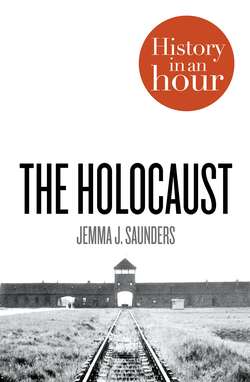Читать книгу The Holocaust: History in an Hour - Jemma Saunders J. - Страница 11
Kristallnacht
ОглавлениеHitler had never made any secret of his desire for Lebensraum: living space for the German people. Nineteen thirty-six saw the remilitarization of the Rhineland, and in March 1938 the Anschluss (union) of Germany and Austria was announced. Once under Nazi control, it became increasingly difficult for Jews in these territories to lead lives that were not tainted by anti-Semitic persecution.
The Austrian Jewish community was subjected to appalling treatment in the immediate aftermath of the Anschluss. Anti-Semitism was already common in Austria, but discrimination now escalated as many Jews were forced to scrub pavements with toothbrushes, while others were humiliated by being made to crudely hack off their beards. Such public degradation was a forewarning of the suffering that would soon engulf Jews across Europe, and in November 1938 the situation was dramatically exacerbated.
On 7 November in Paris, a young Polish Jew named Herschel Grynszpan shot and fatally wounded Ernst vom Rath, a German diplomat. In retribution for vom Rath’s death, Goebbels instigated an anti-Jewish pogrom across Germany. Such was the ferocity of the pogrom that the night of 9–10 November, on which it took place, became known as Kristallnacht – the Night of Broken Glass.
Nearly two-thirds of Jewish businesses in Germany had been Aryanized (transferred to gentile ownership) by April 1938, but well over 7,000 Jewish-owned stores were nevertheless pillaged throughout Kristallnacht, the shattered glass from their windows covering the streets. One hundred and ninety-one synagogues were destroyed, many burned to the ground, and around 30,000 Jewish men were arrested and imprisoned in concentration camps. Many were only detained temporarily in Dachau, Sachsenhausen or Buchenwald, but the Nazi precedent of rounding up and deporting people en masse had been set.
A synagogue burns on Kristallnacht
The material damage perpetrated on Kristallnacht was enormous, and to add insult to injury the Jewish community was declared liable and ordered to pay a fine of 1 billion Reichsmarks to the treasury. Physical violence was also rife and ninety-one Jews were killed on 9–10 November, although the ultimate death toll was significantly higher: fearing that subsequent persecution on a similar or worse scale was inevitable, many Jews committed suicide in the months following Kristallnacht, thereby becoming indirect victims of the pogrom.
